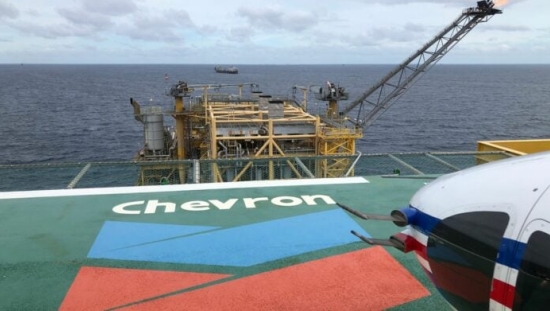Chevron: What the US giant sees in Greek seas
By Lila Chotzoglou

Chevron's decision to explore new natural gas deposits in the Greek seas marks a new chapter in Greece's hydrocarbon research and development, highlighting Greece’s role on the global map.
The decision comes at a time when fossil fuels are attracting interest, both in terms of symbolism in the “drill baby drill” model, and in terms of the challenges of the energy transition.
Chevron’s presence, according to officials who spoke to Naftemporiki, is recognized as a guarantee for the international appeal of the tender, positioning Greece, following the presence of the other US giant Exxon Mobil, at the center of the global oil industry.
“The credibility of natural gas”
“The data that until now underestimated the importance and demand for natural gas at the global and European level are being completely overturned by the second Trump presidency and the growing need for reliable and uninterrupted high-efficiency electricity generation to power data centers and AI units. Natural gas ensures this reliability at a much lower cost and risk than nuclear power. Since 2022, Greece has made a significant shift by prioritizing the exploration of hydrocarbons, especially natural gas, as few European countries do. “The interest and potential entry of Chevron at an early stage in the blocks south of the Peloponnese is a very positive development for the dynamics of the domestic exploration program, which is approaching the critical point where Exxon will have to make its decisions on drilling in the blocks southwest of Crete,” the Professor of Geopolitics and Energy Policy at the University of Nicosia and advisor to the Ministry of Energy and Mineral Resources, Thodoris Tsakiris, said in a statement to Naftemporiki.
The potential economic “footprint”
In addition, Chevron’s involvement in the domestic hydrocarbon exploration and development program is expected to progressively translate into investments of around 165 million euros related to the company’s expenses for implementing the three phases of exploration to cross-check the existence of a natural gas deposit. In particular, as industry executives explained, the first phase, which concerns the acquisition of 2D seismic surveys, is estimated at approximately 10 million euros in cost, with the next phase for the collection of 3D seismic surveys reaching around 15 million euros. If the processing and evaluation of the data collected from the first two phases “justify” the next step, which is the implementation of exploratory drilling, then the amount increases by approximately 100-140 million euros for Chevron to reach the point of mining and exploitation of the undersea natural gas reserves.
The US company Chevron has expressed interest in hydrocarbon exploration in a marine area of 11,000 square kilometers south-southwest of the Peloponnese.
The company has purchased all the data resulting from seismic and other surveys that have been conducted in recent years in southern and western Greece, according to the Athens-Macedonian News Agency.
Among these is the data from the large-scale seismic survey conducted in 2012 by PGS in the Ionian Sea and the marine area south of Crete on behalf of the Ministry of Energy.
Chevron’s interest is said to have been expressed after evaluating this data and seeing the possibility of exploitable natural gas reserves in the area.
Next steps
The next steps, which are expected to be implemented rapidly, include:
-the submission of the environmental impact study of the explorations by the Hellenic Hydrocarbons and Energy Resources Management Company to the Ministry of Environment and Energy and the announcement of an international tender and
-the issuance of a decision by the Ministry of Environment and Energy accepting the expression of interest and announcing an international tender, with a notice to be published in the Official Journal of the European Union for possible expressions of interest by other oil companies in the same area. Bids must be submitted within ninety days of publication.
At the same time, the processes are underway to make an investment decision regarding the conduct of exploratory drilling in the areas west and southwest of Crete that was granted in 2019 for research to the ExxonMobil and Helleniq Consortium. In addition, four other areas are in the research phase: one in the onshore area of Ioannina and three offshore areas in the Ionian Sea.
Reserve estimates
According to the published estimates of the Hellenic Hydrocarbons and Energy Resources Management Company, “a conservative estimate of the potential and probable reserves of the areas in question, in which, however, exploratory drilling has not yet been carried out, stands, according to preliminary data, close to 24 trillion cubic feet or 680 bcm of natural gas (risked recoverable reserves). The possible confirmation of these deposits exceeds both the present and future domestic demand for natural gas, making our country an exporter by the end of the decade.”
Why Chevron set its sights on the “southern Peloponnese”
Chevron has been in Greece for a year and a half, evaluating the situation, but it was waiting for details to decide whether it would proceed with the hydrocarbon exploration, Avraam Zelilidis, Professor of Geology at the University of Patras, said in an interview with “Naftemporiki” TV.
“From the moment Trump won and made the statements that we are going to drill, Chevron expressed its interest,” he added.
He also estimated that “Chevron will wait for Exxon’s reaction. Exxon has two goals. One goal and my own assessment is that we only have natural gas, but a company like Exxon doesn’t want to stay with just one drilling with all the risks that entails—it wants to see its entire program. The second drilling that supposedly requested a six-month extension is where I believe there is oil. So it wants to investigate what Greece’s potential is.”
Regarding the quantity, the Geology Professor replied, “The estimates speak of approximately 1 trillion cubic meters of methane. This means that our annual needs of 4 to 5 billion cubic meters can be met for the next 200 years. Everyone talks about these billions of cubic meters, but nobody wants them. This is the strange thing: we have a noose around our necks, and no moves are made, although we can get rid of the debt.”
(Editor: wangsu )


